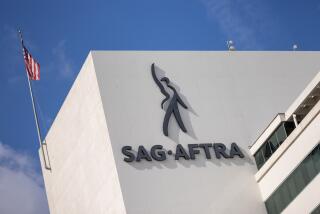Digital Technologies Could Limit Recording
As digital technology transforms TV, it may also put a crimp in one of the most cherished rights of consumers: the ability to record programs for personal use.
Hollywood studios and TV broadcasters have been pushing for the aggressive use of new digital scrambling tools to prevent some types of programs--particularly high-definition TV shows and pay-per-view channels--from being taped or even stored overnight.
One proposal could even block high-definition TV shows from being viewed on many of the high-definition sets on the market today.
The studios say that if they had these protections, they might consider offering new services to consumers, such as earlier broadcasts of first-run movies. But opponents in the consumer electronics industry say Hollywood just wants people to pay more for what they watch in their living rooms.
The impact of the controls, which are still being negotiated, won’t really be felt until digital TV sets, recorders and cable boxes take the place of today’s analog versions. That’s because they apply to digital connections not in use today that ultimately will link devices throughout the home.
The controls will take effect only if cable and satellite TV companies agree to transmit them to their subscribers’ equipment. They may have little choice, however, given that Hollywood can play one against the other to obtain the strongest limits on copying.
“We don’t want to be at a disadvantage,” said William Check, vice president for science and technology at the National Cable Television Assn. Unless the cable operators agree to the same restrictions as their rivals in the satellite industry, he said, “we can’t get early-release movies when our competitors can.”
The proposed recording rules came in response to piracy fears by the motion picture industry, which has been reluctant to release programs in digital form. Unlike today’s analog broadcasts, digital programs can be copied an unlimited number of times with no loss of quality.
Five equipment companies--Sony, Matsushita, Intel, Toshiba and Hitachi--tried to address those concerns with a new technology, dubbed “5C,” that could secure digital audio and video signals against unauthorized copying.
Although there’s wide agreement that copyrights need to be protected, the 5C companies have been negotiating with the seven major Hollywood studios over how extensively to apply the controls. Key questions include which programs will be eligible for protection, what rules will apply to digital recording and display devices, and what rights the studios will have if their programs get pirated.
Seth Greenstein, chairman of the 5C policy group, said one of his group’s fundamental principles has been that the studios and TV networks can’t place recording restrictions on programs that are broadcast unscrambled over the air. And it would limit the most draconian rules--a total ban on copying--to video-on-demand and pay-per-view programs, as well as prerecorded tapes and discs.
For everything in between, including basic cable networks and premium services such as HBO, the 5C companies propose to let viewers make one digital recording, but not multiple copies of it, Greenstein said. And like pay-per-view and video-on-demand programs, those copy-once programs would have to be scrambled if they passed over a digital connection to a TV set or recorder. That scrambling would prevent unencrypted digital copies from being distributed over the Internet.
That’s what the 5C companies have proposed. But there are signs that the broadcast networks and studios want to push the restrictions even further. The National Assn. of Broadcasters, for example, sent a letter to Greenstein on Dec. 15 asking for scrambling and limits on copying.
Some consumer electronics companies and retailers, meanwhile, warn that Hollywood will try to bar televised movies from being recorded for free, forcing consumers to pay for the right to copy. Although federal law and a landmark Supreme Court ruling protect that right for analog programs, there’s no such guarantee in the digital arena.
Brad Hunt, chief technical officer for the Motion Picture Assn. of America, said the studios can’t afford to make their best products available in digital format without greater protections against piracy. “It’s pretty clear that content owners are waiting for a more secure environment to deliver high-definition [programs],” Hunt said.
But the MPAA’s insistence on greater protection could spell bad news for anyone who’s already spent several thousand dollars on a digital TV set.
The studios are insisting that high-definition programs be transmitted digitally, in a scrambled format, from the cable box to the TV set. And today’s sets and so-called HDTV ready or HDTV upgradable monitors can’t connect digitally to a cable converter box.
Another product likely to be affected by the proposed recording rules is the personal video recorder, which records programs temporarily on high-capacity computer discs instead of permanently on tapes.
Under the studios’ current proposal, programs that are designated for no copying would be erased from any personal video recorder after as little as 90 minutes unless the viewer paid for a longer viewing window.
More to Read
The biggest entertainment stories
Get our big stories about Hollywood, film, television, music, arts, culture and more right in your inbox as soon as they publish.
You may occasionally receive promotional content from the Los Angeles Times.











